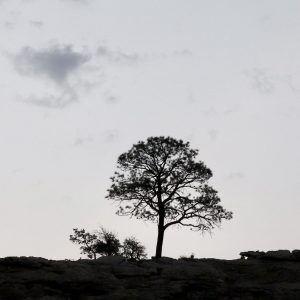Where did this algae bloom of fear come from?
I have spent my life in love with the sky. With breathing room. I have gloried in being small in vast spaces, found a perspective in them that freed me from fuss and gave me the right to take action. To be out in the open on a grassy hillside, with nothing between me and the sky—that is heaven.

I have made my peace with silence. After being forced into it for years, I have lost my horror of what I feared was emptiness. It has become a friend that holds me in its embrace.
And I am at home in solitude. It is my native land, my place of fluency and ease.
So what pinned me, quivering, in a serene, open grassland, like a rabbit in a hawk’s shadow?
I had gone for a short walk at Las Cienegas National Conservation Area southeast of Tucson. It is the kind of landscape that sets my heart singing—a gentle one of rolling, interweaving hills and soaring skies. In mid-November, its blanket of sacaton grasses glowed in late-afternoon sun. The bosque of Arizona ash along that great wonder of southwestern wonders—a year-round river—was just warming to gold. In the distance, “sky island” mountains twisted up from the earth, while the hills in the foreground echoed with birds and the cattle on the Conservation Area’s historic, working ranch.

I had spent the days since my arrival resting. My buggy is a lovely window on the world, and from its shelter the hills had called out. Just across each rise, they promised, a new mystery awaited. Cattle lowed outside my windows every morning, ambled past to the next grazing ground. A kestrel kept watch in an ironwood tree.
When I arrived, I had neighbors one campsite over. I was glad of them. Signs in this border region warn of drug and human smugglers, and I don’t have enough experience to assess the danger. On the second day, the neighbors rumbled away to journey elsewhere. None took their place.

On the third day, I returned to life and ventured out into this landscape so suited to my heart. I started with a spring in my step. When I turned for home, though, the sight of my van—my world—stopped me cold. It sat alone on that vast plain, a speck of white sand on a tiny island in an ocean of grass. It was so very, very small.
I stood there for a minute, under the huge sky in the silence of high noon. I stood all alone.
The thought hit me: “You are a sitting duck.”
As I said, the border promotes fear. I hadn’t anticipated being on my own in a land tailor-made for traffickers during the week of the full moon. Perhaps I was just jumpy? I didn’t detect an immediate threat; the hackles on my neck stayed low. The anxious hamster-wheel of “what-if’s” lives in the mind and adrenal glands. True fear runs deeper, bypassing the conscious mind to galvanize the body. This fear ran deeper yet, to chill the soul. I was small and alone, and the world was vast and empty. (Meanwhile, cattle lowed. Birds sang.)
I happen to believe that a little existential terror is good for the soul. After returning to the van, I sat with fear for a couple of days to sift through it, sorting what-if’s from reality, imagination from gut, coming to terms with my place in the cosmos. I realized that part of the fear was the sense that, in this nomadic life, anything could happen.
Anything.
With that, my heart leapt high. When I was trapped inside four walls, knowing to the minute what every day would bring, I had withered. The sense that nothing would happen almost brought me to despair. Knowing now that anything could happen—yes, that might be fear. But it also looked remarkably like hope.

For two mornings I rode that wave, balanced between fear and hope, keenly, painfully aware of the fragile, astounding gift of life. Every morning, the cows ambled by. Birds sang. I came to a delicate truce, where hope and fear shook hands.
Again on the third morning, I went for a walk, while the horizon stretched out on all sides. Again I was pinned with terror. But this time I knew the difference between what-if’s and the now, between body and soul. This time was different.
No cattle lowed. No birds sang.
A pause to listen. Yes, there—in the distance they did. Just the circle around me was silent.
And then I knew the peace of turning tail and running.
To be continued…
